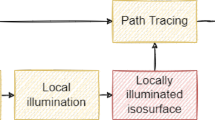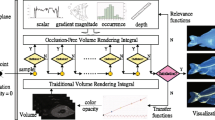Abstract
Direct volume rendering (DVR) is a powerful visualization technique which allows users to effectively explore and study volumetric datasets. Different transparency settings can be flexibly assigned to different structures such that some valuable information can be revealed in direct volume rendered images (DVRIs). However, end-users often feel that some risks are always associated with DVR because they do not know whether any important information is missing from the transparent regions of DVRIs. In this paper, we investigate how to semi-automatically generate a set of DVRIs and also an animation which can reveal information missed in the original DVRIs and meanwhile satisfy some image quality criteria such as coherence. A complete framework is developed to tackle various problems related to the generation and quality evaluation of visibility-aware DVRIs and animations. Our technique can reduce the risk of using direct volume rendering and thus boost the confidence of users in volume rendering systems.
Similar content being viewed by others
References
He T, Hong L, Kaufman A, Pfister H. Generation of transfer functions with stochastic search techniques. In Proc. IEEE Visual. Conf., San Francisco, USA, Oct. 27-Nov. 1, 1996, pp.227–234.
Kindlmann G, Durkin J W. Semi-automatic generation of transfer functions for direct volume rendering. In Proc. IEEE Symposium on Volume Visualization, Research Triangle Park, USA, Oct. 24, 1998, pp.79–86.
Kniss J, McCormick P, McPherson A, Ahrens J, Painter J, Keahey A, Hansen C. Interactive texture-based volume rendering for large data sets. IEEE Computer Graphics and Applications, 2001, 21(4): 52–61.
König A, Gröller E. Mastering transfer function specification by using volumepro technology. In Proc. Spring Conference on Computer Graphics, Budmerice, Slovakia, Apr. 25–28, 2001, pp.279–286.
Tzeng F Y, Lum E B, Ma K L. A novel interface for higher-dimensional classification of volume data. In Proc. IEEE Visual. Conf., Seattle, USA, Oct. 19–24, 2003, pp.505–512.
Correa C, Ma K L. Visibility-driven transfer functions. In Proc. IEEE Pacific Visualization Symposium, Beijing, China, Apr. 20–23, 2009, pp.177–184.
Mitchell M. An Introduction to Genetic Algorithms. Cambridge: MIT Press, MA, USA, 1996.
House D, Bair A, Ware C. On the optimization of visualizations of complex phenomena. In Proc. IEEE Visualization Conf., Minneapolis, USA, Oct. 23–28, 2005, pp.87–94.
Wu Y, Qu H. Interactive transfer function design based on editing direct volume rendered images. IEEE Trans. Visual. Comput. Graph., 2007, 13(5): 1027–1040.
Sheikh H R, Sabir M F, Bovik A C. A statistical evaluation of recent full reference image quality assessment algorithms. IEEE Trans. Image Processing, 2006, 15(11): 3441–3552.
Sheikh H R, Bovik A C, Cormack L. No-reference quality assessment using natural scene statistics: JPEG2000. IEEE Transactions on Image Processing, 2005a, 14(11): 1918–1927.
Gunawan I P, Ghanbari M. Reduced-reference video quality assessment using discriminative local harmonic strength with motion consideration. IEEE Transactions on Circuits and Systems for Video Technology, 2008, 18(1): 71–83.
Wang Z, Bovik A C. Modern Image Quality Assessment. Morgan and Claypool Publichers, 2006.
Wang C, Garcia A, Shen H W. Interactive level-of-detail selection using image-based quality metric for large volume visualization. IEEE Transactions on Visualization and Computer Graphics, 2007, 13(1): 122–134.
Wang C, Ma K L. A statistical approach to volume data quality assessment. IEEE Transactions on Visualization and Computer Graphics, 2008, 14(3): 590–602.
Gröller M E, Purgathofer W. Coherence in computer graphics. Technical Report, TR-186-2-95-04, Institute of Computer Graphics and Algorithms, Vienna University of Technology, Austria, March 1995, Contact: technical-report@cg.tuwien.ac.at.
Lundstrom C, Ljung P, Ynnerman A. Local histograms for design of transfer functions in direct volume rendering. IEEE Trans. Visual. Comput. Graph., 2006, 12(6): 1570–1579.
Weiskopf D, Engel K, Ertl T. Interactive clipping techniques for texture-based volume visualization and volume shading. IEEE Trans. Visual. Comput. Graph., 2003, 9(3): 298–312.
Viola I, Kanitsar A, Gröller M E. Importance-driven feature enhancement in volume visualization. IEEE Trans. Visual. Comput. Graph., 2005, 11(4): 408–418.
Krüger J, Schneider J,Westermann R. Clearview: An interactive context preserving hotspot visualization technique. IEEE Trans. Visual. Comput. Graph., 2006, 12(5): 941–948.
Bruckner S, Grimm S, Kanitsar A, Gröller M E. Illustrative context-preserving exploration of volume data. IEEE Trans. Visual. Comput. Graph., 2006c, 12(6): 1559–1569.
Rezk-Salama C, Kolb A. Opacity peeling for direct volume rendering. Computer Graphics Forum, 2006, 25(3): 597–606.
Author information
Authors and Affiliations
Corresponding author
Additional information
The work is supported in part by Hong Kong RGC CERG under Grant No. 618705.
Rights and permissions
About this article
Cite this article
Mak, WH., Wu, Y., Chan, MY. et al. Visibility-Aware Direct Volume Rendering. J. Comput. Sci. Technol. 26, 217–228 (2011). https://doi.org/10.1007/s11390-011-9428-3
Received:
Revised:
Published:
Issue Date:
DOI: https://doi.org/10.1007/s11390-011-9428-3




